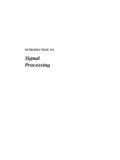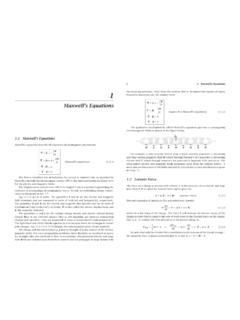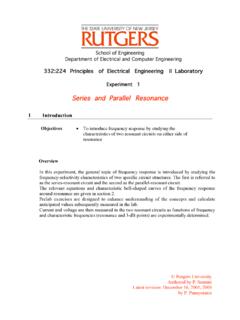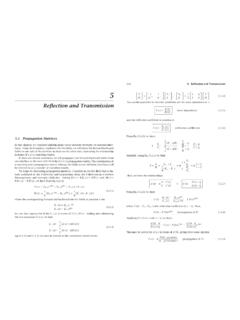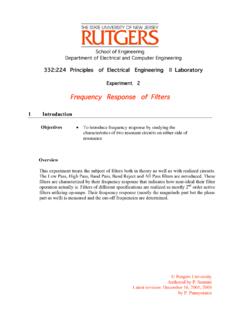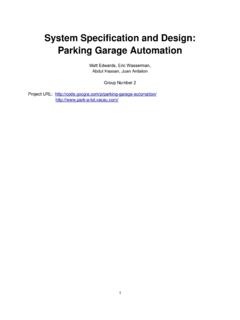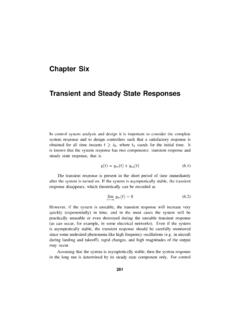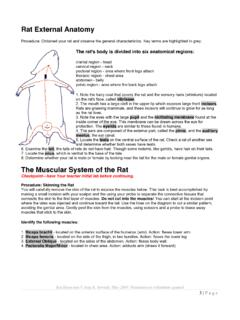Transcription of 3.1 State Space Models - Rutgers University
1 ,obtainedviadualitywiththecontinuous-tim emodels, continuous-timedynamicsystemcanbederived eitherfromthesystemmodelgiveninthetimedo mainbya thephasevariableform(controllerform),the observerform,themodalform,andtheJordanfo rm whichareoftenusedinmoderncontroltheoryan dpractice, generalth-ordermodelofa dynamicsystemrepre-sentedbyanth-orderdif ferentialequation ( )Atthispointweassumethatallinitialcondit ionsfortheabovedifferentialequation, , systematicprocedurethattransformsadiffer entialequationofordertoa statespaceformrepresentinga systemoffirst-orderdifferentialequations ,wefirststartwitha simplifiedversionof( ),namelywestudythecasewhenno9596 STATESPACEAPPROACH derivativeswithrespecttotheinputareprese nt ( )Introducethefollowing(easytoremember)ch angeofvariables .. ( )whichaftertakingderivativesleadsto.
2 ( )STATESPACEAPPROACH97 Thestatespaceformof( )isgivenby ..( )withthecorrespondingoutputequationobtai nedfrom( )as .. ( )Thestatespaceform( )and( )is ( ),whichincludesderivativeswithrespecttot heinput,weformanauxiliarydifferentialequ ationof( )havingtheformof( )as ( )98 STATESPACEAPPROACH forwhichthechangeofvariables( )isapplicable .. ( )andthenapplythesuperpositionprincipleto ( )and( ).Sinceistheresponseof( ),thenbythesuperpositionpropertytherespo nseof( )isgivenby ( )Equations( )producethestatespaceequationsintheforma lreadygivenby( ).Theoutputequationcanbeobtainedbyelimin ating from( ),byusing( ),thatis Thisleadstotheoutputequation .. ( )It is interestingtopointoutthatfor , whichis almostalwaysthecase,theoutputequationals ohasaneasy-to-rememberformSTATESPACEAPPR OACH99givenby .. ( )Thus,insummary,fora givendynamicsystemmodeledbydif-ferential equation( ),oneisabletowriteimmediatelyitsstatespa ceform,givenby( )and( ),justbyidentifyingcoeffi-cients and , :Considera dynamicalsystemrepresentedbythefollowing differentialequation!
3 #"%$!#&%$!(')$! $! $!#*%$! $where! $standsforthethderivative, ! $ .Accordingto( )and( ), ,wepresenttwomethods,knownasdirectandpar allelprogrammingtechniques, ,likeintheprevioussubsection, ,wherebytransferfunctionmodeswemeanpoles oftheoriginaltransferfunction(beforezero -polecancellation,ifany,takesplace).Ifso mezerosandpolesinthetransferfunctionarec ancelled, ,wefirstusedirectprogrammingtechniquesto derivethestatespaceformsknownasthecontro llercanonicalformandtheobservercanonical form;then,bythemethodofparallelprogramin g, convenientinthecasewhentheplanttransferf unctionisgivenina nonfactorizedpolynomialform+++ , -+ , --.++ , -+ , --.( )Forthissystemanauxiliaryvariableisintro ducedsuchthatSTATESPACEAPPROACH101thetra nsferfunctionissplitas// 0 1/ 0 112( )/// 0 1/ 0 112( )Theblockdiagramforthisdecompositionis (s)V(s)V(s)/U(s)Y(s)/V(s)Y(s) :Blockdiagramrepresentationfor( )Equation( )hasthesamestructureas( ),aftertheLaplacetransformationis applied,whichdirectlyproducesthestatespa cesystemequationidenticalto( ).
4 It remainstofindmatricesfortheoutputequatio n( ).Equation( )canberewrittenas333 4 53 4 556( )indicatingthatis justa ( )maybeconsideredasa differentialequationintheoperatorformfor zeroinitialconditions,where. Inthatcase,,, andaresimplyreplacedwith,,and, , ,adders,subtracters,andmultipliers, ,functiongeneratorsareusedto simulationdiagramis is relativelyeasytodraw(design)a simulationdiagramfora givendynamicsystem, ( ) ,respectively,by7#8:97#8 Useformula( )toconstruct, ( ,whererepresentstheintegratorblock).From ( )wehavethat7#8:98 ; <7#8 ; uHyIbJ0bnbJ2bJ1-a0-a1-an-1vK(n-1)vK(1)v1 :Simulationdiagramforthedirectprogrammin gtechnique(controllercanonicalform)Asyst ematicproceduretoobtainthestatespaceform froma simulationdiagramistochoosetheoutputsofi ntegratorsasstatevariables.
5 Usingthisconvention, , P ( )104 STATESPACEAPPROACHandQQRSSRR T SR T SRR( )Thisformofthesystemmodeliscalledthecont rollercanon-icalform. Itisidenticaltotheoneobtainedintheprevio ussec-tion equations( )and( ).Controllercanonicalformplaysanimportan troleincontroltheorysinceit is importanttopointoutthattherearemanystate spaceformsfora givendynamicalsystem, ,togetherwiththedevelopmentofotherimport antstatespacecanonicalforms,canbefoundin Kailath(1980; ).NotethattheMATLAB functiontf2ssproducesthestatespaceformfo ra giventransferfunction,infact,it ( )andSTATESPACEAPPROACH105( ),thestatespacecontrollercanonicalformis givenbyandDirectProgrammingTechniqueandO bserverCanonicalFormInadditiontocontroll ercanonicalform, ( )iswrittenintheformZZ [ \Z [ \\]ZZZ [ \Z [ \\]( )andexpressedasZZ [ \Z [ \\]ZZZZ [ \Z [ \\]( )106 STATESPACEAPPROACH leadingto^ _=`a^ _a^ _ ``^b^^ _ `a^ _a^ _ ``^b( )Thisrelationshipcanbeimplementedbyusing a simulationdi-agramcomposedofintegratorsi na cascade, ,termscontainingshouldpassthroughonlyone integrator,signals^ _aand^ _ashouldpassthroughtwointegrators, ,signalsbandbshouldbeintegrated-times, (t)dy(t)exf2-a0+1/sxf2bc1-a1+1/sxfn-1xfn 1/sxfn-1xfnbcn-1-an-1+1/sbcn+.]]]]
6 Simulationdiagramforobservercanonicalfor mDefiningthestatevariablesastheoutputsof integrators,andrecordingrelationshipsamo ngstatevariablesandthesystemout-put,wege tfromtheabovefiguregg( )hiiigiigjhhhhhghhgkjjjjjgjjggg lhg lhg lhg lhg lhgg lhg lhg( )Thematrixformofobservercanonicalformise asilyobtainedfrom( )and( ) qop qnp qnp( )andp( ) veryusefulforcomputersimulationoflineard ynamicalsystemssinceit ,thisformrepresentsanobservablesystem,in thesensetobedefinedinChapter5,whichmeans thatallstatevariableshaveanimpactonthesy stemoutput,andviceversa,thatfromthesyste moutputandstateequationsoneisabletorecon structthestatevariablesSTATESPACEAPPROAC H109atanytimeinstant,andofcourseatzero,a ndthus,determinerstintermsoftheoriginali nitialconditionsuuturutur. ,withoutlossofgenerality,thatthepolynomi alinthenumeratorhasdegreeof, thenvrstrrsstt( )Hererstaredistinctrealroots(poles) formis (t)wy(t)x yxz2xz2-p2+k{21/sxz1xz1-p1+k{11/sxznxzn- pn+k{n1 :Thesimulationdiagramfortheparallelprogr ammingtechnique(modalcanonicalform)Thest atespacemodelderivedfromthissimulationdi agramisgivenby|}.}}
7 ~..|}~( )Thisformisknownintheliteratureasthemoda lcanonicalform(alsoknownasuncoupledform) . :Findthestatespacemodelofa andthestatespaceformobtainedbyusing( )and( )ofthedirectprogrammingtechniqueisNoteth attheMATLAB functiontf2ssproduceswhichonlyindicatesa permutationinthestatespacevariables,that isEmployingthepartialfractionexpansion(w hichcanbeobtainedbytheMATLAB functionresidue),thetransferfunctioniswr ittenas112 STATESPACEAPPROACHT hestatespacemodel,directlywrittenusing( ),isNotethattheparallelprogrammingtechni quepresentedis , :Leta transferfunctioncontaininga pairofcomplexconjugaterootsbegivenbyWe firstgroupthecomplexconjugatepolesina second-ordertransferfunction,thatis Then, ,correspondingtothepairofcomplexconjugat epoles,isimplementedusingdirectprogrammi ng, ,wherethecontrollercanonicalformis usedtorepresenta sothattherequiredstatespaceformisu(t)wy( t)x yxz2xz2-10+3 1/sxz1xz1-5+ 21/sxz4xz3xz3xz4-2-2+8 8 1/s1.
8 Simulationdiagramforasystemwithcomplexco njugatepoles114 STATESPACEAPPROACHM ultipleRealRootsWhenthetransferfunctionh asmultiplerealpoles, realpole ofthetransferfunctionhasmultiplicityandt hattheotherpolesarerealanddistinct,thati s > Thepartialfractionformoftheaboveexpressi onis > @ Thesimulationdiagramforsucha systemis (t) k1r-1k11u(t)x 2-p1+ 1/sx rx r-p1+ 1/sx r+1-pr+1+ k r+11/sx n-pn+1/sk nx r+1x nx 2x 1x 1-p1+ k 1r1 :ThesimulationdiagramfortheJordancanonic alformTakingforthestatevariablestheoutpu tsofintegrators,thestateSTATESPACEAPPROA CH115spacemodelisobtainedasfollows .. % .. > .. ( ) % > > > Thisformofthesystemmodelis knownastheJordancanonicalform. ThecompleteanalysisoftheJordancanonicalf ormrequiresa ,understandingtheJordanformis crucialforcorrectinterpretationofsystems tability,henceinthefollowingchapter.
9 Findthestatespacemodelfromthetransferfun ctionusingtheJordancanonicalform Thistransferfunctioncanbeexpandedas (ordinaryth-orderdifferentialequation,st atespaceortransferfunction), differentialth-ordersystemmodelintheoper atorform wheretheoperatorisdefinedas and, thenthecharacteristicequation, accordingtothemathematicaltheoryoflinear differentialequations(BoyceandDiPrima,19 92),isdefinedby ( )Notethattheoperatorisreplacedbythecompl exvariableplayingtheroleofa ( )that Thecharacteristicequationhereisdefinedby ( ) single-inputsingle-outputsystemis ( ) ,thecharacteristicpolynomial(obtainedfro mthecorrespondingcharacteristicequation) , ( )and( ),butisnotsoclearfrom( ).It isleftasanexercisetothereadertoshowthat( )and( )areidentical( ).Theeigenvaluesaredefinedinlinearalgebr aasscalars,,satisfying(FraleighandBeaure gard,1990)( )118 STATESPACEAPPROACH wherethevectorsarecalledtheeigenvectors.
10 Thissystemoflinearalgebraicequations(isf ixed)hasa solutionifandonlyif( )Obviously,( )and( ) ( )=( ),it followsthatthelastequationisthecharacter isticequa-tion, , thenumberofeigenvaluesisequalto. Thus,therootsofthecharacteristicequation inthestatespacecontextaretheeigenvalueso fthema-trix. Theserootsinthetransferfunctioncontextar ecalledthesystempoles, accordingtothemathematicaltoolsforanalys isofthesesystems havepointedoutbeforethata ,weestablisha relationshipamongthosestatespaceformsbyu singa givensystem wecanintroducea newstatevectorbya ( )STATESPACEAPPROACH119where = ( ) ,thatis, ( )Notethatinthisproofthefollowingproperti esofthematrixdeterminanthavebeenused thatthetransferfunctionremainsthesamefor bothmodels,whichcan120 STATESPACEAPPROACH beshownasfollows ( )Notethatwehaveusedin( )thematrixinversionproperty(AppendixC) Theaboveresultisquitelogical thesystempreservesitsin-put outputbehaviornomatterhowit is , where thenhave ( )
